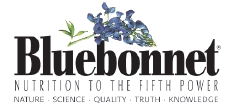Part Two of a Five-Part Series on Sports Nutrition
Imagine if you collected all the protein powder containers you’ve sold in the past 20 years. You and your staff could likely erect a wall to rival the one built by the ancient Chinese.
Your average consumer may most closely associate sports nutrition with protein powder, but today’s market is completely different. With products supporting a pre-, during- and post-workout regimen, shoppers have a lot to choose from, whether it’s alternative sources of protein or muscle recovery products.
Timing Is Everything
While the staged approach to sports nutrition seems like a fairly new concept, Kevin Wright, president of RightWay Nutrition, Bluffdale, UT, says it’s really not. Product manufacturers are sort of playing catch-up. He states, “Professionals have been using the approach for decades, although until recently, products have not become readily available.”
And, this approach has benefits for both you and 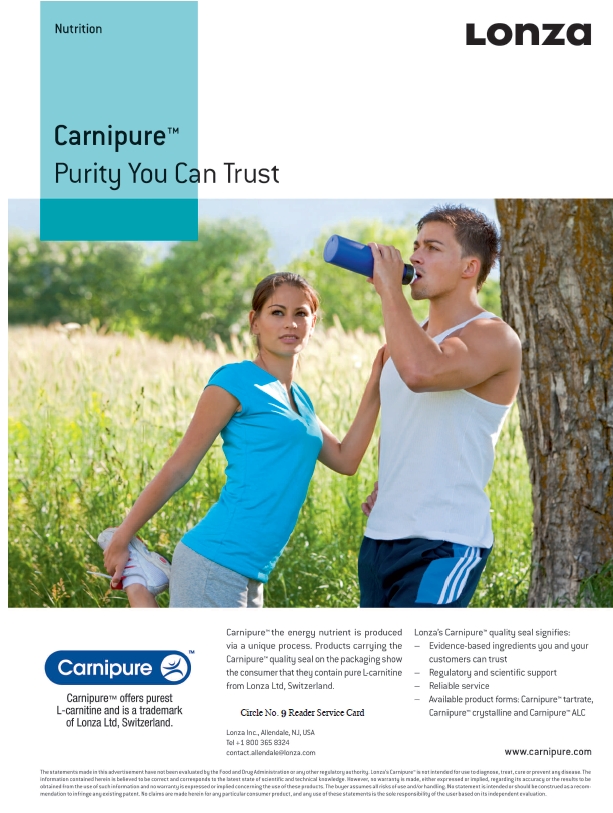 your shoppers. Michael Crabtree, CPT/CSCS, ISSN, CISSN, sales manager of sports nutrition and supplements for Bioenergy Life Science, Minneapolis, MN, states, “From a business standpoint, it provides the latitude to market three products instead of one.” For shoppers, the supplement program should match the intensity and duration of the activity, he feels. Thus, hardcore training can really benefit from a three-stage approach because it “allows for longer and more intense training, with expedited recovery,” he states, adding. “For serious athletes in competition, this is a no-brainer; careful attention to detail including before, during and after is a rule, not an exception.”
your shoppers. Michael Crabtree, CPT/CSCS, ISSN, CISSN, sales manager of sports nutrition and supplements for Bioenergy Life Science, Minneapolis, MN, states, “From a business standpoint, it provides the latitude to market three products instead of one.” For shoppers, the supplement program should match the intensity and duration of the activity, he feels. Thus, hardcore training can really benefit from a three-stage approach because it “allows for longer and more intense training, with expedited recovery,” he states, adding. “For serious athletes in competition, this is a no-brainer; careful attention to detail including before, during and after is a rule, not an exception.”
The benefits of nutrient timing during exercise aren’t just guesswork; they are research backed, according to Brendan Brazier, former professional triathlete, developer of ThriveForward.com, author of the Thrive book series and formulator of Vega plant-based nutritional products, Burnaby, BC, Canada. “Leading researchers and organizations, such as the International Society of Sports Nutrition, strongly support the notion that different nutrients are crucial at different stages of exercise…Choosing carefully what you put in your body during all phases of training results not only in better performance, but also enhances the long-term effectiveness of your training,” he says.
The stages. Tim Hammond, director of sales and strategic relations at Bergstrom Nutrition, Vancouver, WA, believes a pre-workout supplement “is an absolute MUST for anyone who is serious about their training or competition.” It helps athletes fuel up before training or competing, which he says is “critically important because a fully fueled body can mean the difference between a great workout and a shortened workout.” Plus, choosing the right nutrients may even reduce the chance of muscle injury.
Partly for these reasons, JR Ortiz, vice president of Macrolife Naturals, Culver City, CA, believes the popularity of crossfit and other high-intensity workout programs has spurred the demand for preworkout supplements.
Trisha Sugarek MacDonald, B.S., M.S., director of research and development and national educator for Bluebonnet Nutrition Corporation, Sugar Land, TX, gets us started with some facts about the pre-exercise stage, considered about two to four hours before physical activity. Carbohydrates consumed then improve muscle and glycogen stores and maintain blood glucose. The result? Participants may be able decrease how much time they need to finish a planned workout.
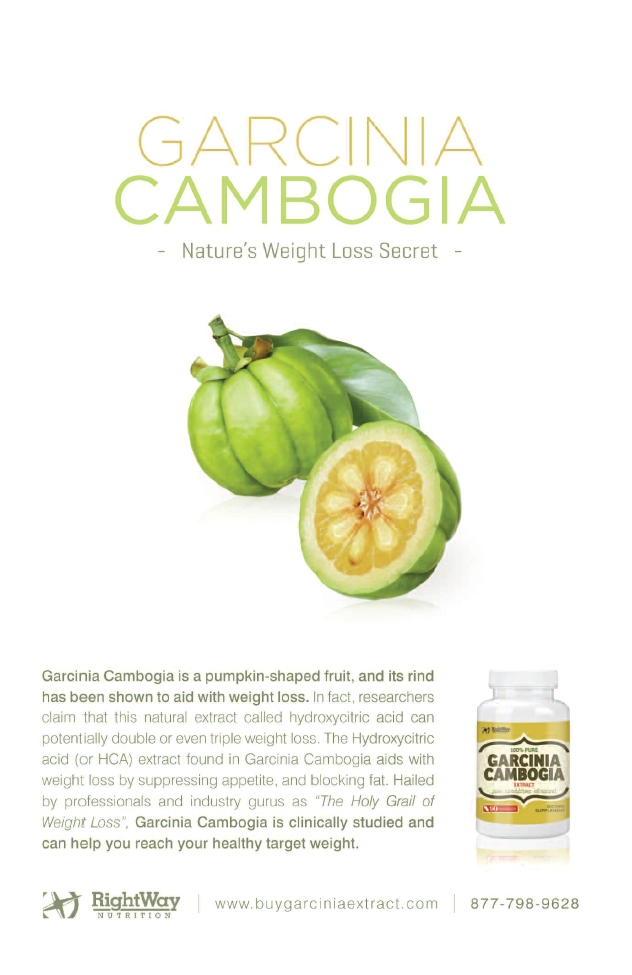 But, shoppers need to know that not just any carb will do. “It is discouraged to consume complex carbohydrates within one hour of planned sport, since it can induce hyperinsulinaemia (i.e., increase in plasma insulin), which lowers blood glucose and can potentially interfere with athletic performance by causing fatigue,” she explains.
But, shoppers need to know that not just any carb will do. “It is discouraged to consume complex carbohydrates within one hour of planned sport, since it can induce hyperinsulinaemia (i.e., increase in plasma insulin), which lowers blood glucose and can potentially interfere with athletic performance by causing fatigue,” she explains.
Pre-exercise isn’t just about carbs, says Sugarek MacDonald. Taking protein or amino acids before resistance training—even without carbs—“can enhance muscle protein synthesis.” Sugarek MacDonald’s preferences for amino acids are three to six grams of arginine, lysine and branched chain amino acids (BCAAs). She also recommends adding in “responsible amounts of caffeine to spur the body into action—not just physically, but mentally.” The benefits of all these components, she says, are increased energy and better mental focus.
To this list of beneficial pre-exercise supplements, Bioenergy Ribose president Tom VonderBrink adds D-ribose, which is also appropriate after exercise. “Having supplemental ribose on board as you do strenuous exercise will drive the pure nucleotide salvage pathway once your muscles reach a demand versus supply mismatch and begin to deplete ATP levels,” he explains. So if ribose is in an athlete’s system, he or she won’t get fatigued as quickly.
The regimen is different for those looking for less-intense workouts. Those looking for a short workout should focus on staying hydrated with water and electrolytes, Brazier believes, and skip the focus on carbs.
Moving on, David Janow, CEO of Axiom Foods, Los Angeles, CA, adds that serious athletes who want to build muscle or improve performance can use timed nutrition during activity to replenish glycogen stores, offset muscle damage and facilitate prolonged periods of exercise.
Carbs can also be helpful for this purpose, according to Sugarek MacDonald, because they help the body do more work by maintaining blood glucose levels, supporting high carb oxidation, sparing endogenous glycogen and synthesizing glycogen during low-intensity exercise. Thus, this type of supplementation is especially important for endurance athletes, states Hammond.
The amount of carbs needed to achieve these effects varies by the athlete and their level of physical activity, though Sugarek MacDonald sets out these parameters: as little as 16 g/hour may help, while amounts over 75 g/hour were not found to be beneficial in studies. “Mixtures are typically administered as 10 grams every 30 minutes or 21 grams every 60 minutes,” she explains.
Again, there’s more to the picture than just carbs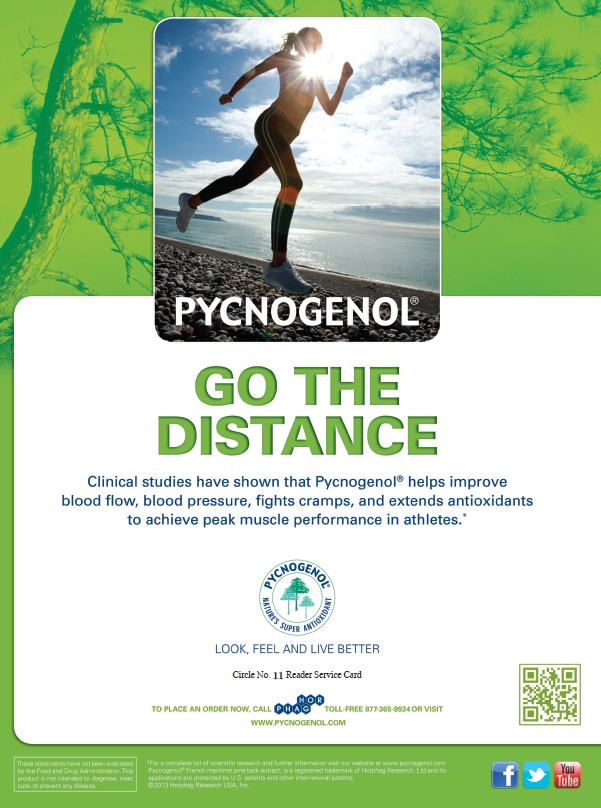 ; she says a protein–carb combo will have the dual benefit of enhanced performance and improved muscle recovery. This is especially beneficial for strength-training individuals since protein intake helps decrease cortisol levels, increase insulin levels and helps maintain muscle protein.
; she says a protein–carb combo will have the dual benefit of enhanced performance and improved muscle recovery. This is especially beneficial for strength-training individuals since protein intake helps decrease cortisol levels, increase insulin levels and helps maintain muscle protein.
“Carbohydrate formulas can help refuel the glycogen stores of the liver and muscles two days prior to a marathon or triathlon event,” she adds, noting that helpful complex carbohydrates include waxy maze, steal cut oats, brown rice and maltodextrin. The source, says Sugarek MacDonald, is important because “when you are refueling the body, you want carbohydrate sources that don’t just temporarily spike blood glucose levels but are steady and provide the cells with ample energy so athletes can go the distance.”
Additionally, formulas may help support glucose and insulin levels with nutrients like alpha lipoic acid, cinnamon and chromium, which help keep sugar levels stable.
Post-workout nutrition (about 150 calories) is also key because “your muscles are starving for nutrients, especially fast-
acting carbohydrates and quick-absorbing protein,” states Sugarek MacDonald. She says post-workout nutrition should:
• create an anabolic state
• remove metabolic waste
• replenish glycogen
• build muscle
• bolster the immune system.
She explains the timeframe for these important jobs to occur is fairly short: “The window of opportunity opens and shuts very quickly, so you need to act fast. One hour after your workout, the window begins to close; after four hours, the window is shut!”
So, what should shoppers feed their bodies during this timeframe? Again, the focus is on carbs and protein, this time in about a three-to-one ratio for endurance athletes and one-to-three for extreme bodybuilders.
Sugarek MacDonald recommends about 60 grams of carbohydrates (taken right after exercise to replenish muscle glycogen), with a preference of glucose and sucrose because “they elicit a higher level of muscle glycogen synthesis.”
In addition to carbs, she recommends adding 20 grams of protein (one to three hours after a workout) “since protein helps to reduce delayed onset muscle soreness in athletes who achieve muscle failure (infamously seen in bodybuilders).” She believes that a high-quality, fast-acting protein like whey protein isolate and complex carbohydrates like waxy maize are the best choices.
 Meanwhile, Rafael Avila, manager of research and development at Nature’s Plus, Melville, NY, likes vegetarian protein such as a blend of rice protein, pea protein, isolated soy protein and fermented soy—especially when the supplement includes vitamins and a broad profile of essential minerals. “This helps those looking to build muscle not only recover at a faster rate, but also provides them with the nutrition they need for daily life, all at once,” he feels.
Meanwhile, Rafael Avila, manager of research and development at Nature’s Plus, Melville, NY, likes vegetarian protein such as a blend of rice protein, pea protein, isolated soy protein and fermented soy—especially when the supplement includes vitamins and a broad profile of essential minerals. “This helps those looking to build muscle not only recover at a faster rate, but also provides them with the nutrition they need for daily life, all at once,” he feels.
Thus, the need for a post-exercise boost is still a key market segment. States Hammond, “People are still—and rightfully so—using a post-workout shake or nutrition product. The need to ‘refuel and rebuild’ muscles after training or competition has not changed and never will.”
VonderBrink adds that taking ribose after a workout will drive ATP synthesis to speed recovery. He adds, “The half-life of ribose is only about 35 minutes, so if strenuous exercise lasts over 2.5–3 hours, taking some additional ribose during exercise is beneficial.”
Other beneficial nutrients after exercise include antioxidants for inflammation support and immune system-benefiting zinc and l-glutamine. Says Brazier, “Including these nutrients beyond just protein will help your body repair and refuel so it can build muscle faster. Consuming the right foods at the right time will help you build functional muscle.”
The advantages. While the three-phased approach may require a little more planning than simply downing a shake after exercise, Wright says the benefits are well worth it. “Each product is an important part of the total workout regimen, the pre- providing fuel and energy to muscle cells, the during enabling muscle cells to develop at their optimum level, and the post- providing recovery vitamins that rebuild muscle faster. For an excellent physique, and even an improved workout, this approach should not be overlooked,” he states.
So in the end, when people are smart about their nutritional intake, says Marc Stover, director of marketing at Twinlab Corporation, New York, NY, “They look to exploit this information to intensify their workouts...to push themselves harder. Stronger workouts generally equal better/faster results, and when you see results, you’re more likely to stick with or even increase your efforts...in the gym and often with your acceptance and use of supplements.”
Shoppers also like the fast results phased workout supplements provide. Stover states, “Pre-workouts in particular have the benefit of direct feedback to the user, delivering benefits like energy and anti-fatigue properties that you feel often within 15–30 minutes, and intra- and post-workout products have similar phenomena.”
Massive Benefits
There is a boatload of advice out there for how to use nutrition products to bulk up. Here, we give you the advice of supplements experts who are up on the science behind why certain nutrients are must-haves for muscle support.
First up is creatine, which Dallas Clouatre, 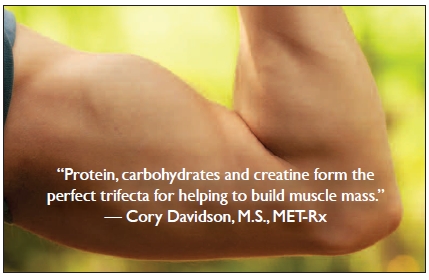 Ph.D., consultant for R&D, Jarrow Formulas, Inc., Los Angeles, CA, calls the “single best nutrient for building mass.” Janow agrees that creatine is important, stating, “Research has indicated that creatine supplementation is an effective way to increase strength, muscle mass and performance, though it is a substance that can be made naturally in the body.”
Ph.D., consultant for R&D, Jarrow Formulas, Inc., Los Angeles, CA, calls the “single best nutrient for building mass.” Janow agrees that creatine is important, stating, “Research has indicated that creatine supplementation is an effective way to increase strength, muscle mass and performance, though it is a substance that can be made naturally in the body.”
Creatine gives muscle fibers that are involved in strength and mass extra energy, Clouatre states. “Endurance-type slow twitch muscle fibers do not yield much mass, and therefore those particular tissues do little to add bulk,” he explains. “Creatine tends to lead to minor edema in the muscles. This fluid retention itself can give the appearance of size and fullness.”
Stover also likes creatine, especially an ingredient used by his company (CreaPure from AlzChem AG), which he says is supported by “a huge body of evidence that shows its ability to boost creatine phosphate in the body, which is used to help replenish ATP.” ATP is key for providing energy to cells, which Stover says is especially important when quick energy bursts are needed such as for sprints and lifting weights. Thus, creatine indirectly helps athletes push farther and longer.
Creatine production is also linked to another nutrient: l-arginine. Clouatre says that while many people push this supplement as a way to produce nitric oxide (and improve blood flow and recovery), he says “consuming nine grams of l-arginine can lead to the synthesis of two to three grams of creatine and thus back to some muscle building and tissue fluid retention experienced with creatine.” In addition, Brazier feels glutamine “facilitates muscle growth while supporting your immune system.”
BCAAs like leucine are also favorites of those interviewed for this piece. Leucine increases insulin release, and it is said to “activate local muscle tissue anabolism as long as adequate protein is available for muscle building,” according to Clouatre.
Rich Mihalik, director of innovation and product development at National Enzyme Company, Forsyth, MO, says certain protein sources contain BCAAs and when formulated to release the amino acid content, it helps builds lean mass at a faster rate. He explains the process: “You can support the release of these amino acids by extensively hydrolyzing the protein in expensive chemical processes or by combining the more natural protein with digestive enzymes to support the release of the amino acids. A combination of the two approaches can also be used to ensure a protein powder goes into suspension well while supporting amino acid availability.”
Wright believes hydrolyzed whey protein is one of best choices for building muscles because it “is the purest form of protein and is most easily assimilated by muscles for utilization. Although it can be more expensive than other forms, some of those forms only offer 10–20% assimilation.” He underscores the importance of using the right kind of protein.
Sugarek MacDonald adds that fast-acting whey protein isolate is “the king of nutrients for bodybuilders or those interested in building up their muscle mass for a more toned look.” She believes that the aminos found in whey protein isolate help with protein synthesis, which is important for muscle building.
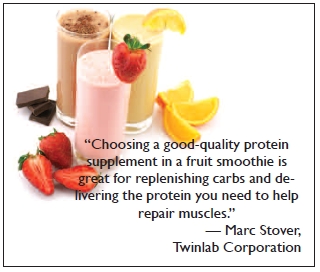 The reasons behind this attribute, she explains, is that whey isn’t coagulated by the gastric juices, so the body can assimilate it easily. Once whey enters one’s system, aminos are quickly released in the blood where they can enhance muscles. She feels that the isolate form is especially beneficial because it offers a high elemental amount of protein per serving.
The reasons behind this attribute, she explains, is that whey isn’t coagulated by the gastric juices, so the body can assimilate it easily. Once whey enters one’s system, aminos are quickly released in the blood where they can enhance muscles. She feels that the isolate form is especially beneficial because it offers a high elemental amount of protein per serving.
Meanwhile, Stephen Lukawski, sales development for Fruit d’Or Inc., Quebec, Canada, believes in cranberry-derived protein powder. He says this kind of protein contains BCAAs, high gamma tocopherol, alpha tocopherol, proanthocyanidins, tocotrienols, carotenes, minerals and phospholipids, which he calls “the building blocks for cell membranes.” Lukawski feels that such a broad-base spectrum of nutrients is essential for muscle building.
Brazier also supports the use of plant-based proteins because they help with muscle building without causing “nutritional debt.” He recommends avoiding highly acid-forming proteins. “Look for raw, minimally processed proteins rich in chlorophyll such as hemp, pea, algae, legumes and dark leafy greens,” he says.
Protein helps for other reasons, too. Avila says that protein helps muscle micro-tears heal faster, which makes for less soreness and faster rebuilding.
But Cory Davidson, M.S., manager of nutrition research at MET-Rx, Ronkonkoma, NY, believes that protein isn’t the only game in town. “Many people working out in the gym only focus on protein while ignoring carbs,” he states, noting that carbs along with protein help replenish muscle glycogen.
Another suggestion for muscle building comes from Chase Hagerman, business development and marketing manager at Chemi Nutra, Bear Lake, MN. Phosphatidic acid (PA), he says, “is showing impressive gains in lean muscle mass and strength.” He explains that PA is a common phospholipid compound that plays a critical role in activating a protein called mTOR, which regulates cellular growth and protein synthesis. He states, “A major role of mTOR is to integrate environmental stimuli (nutrient and growth factor levels, mitochondrial signals and exercise) in order to control cellular growth.”
He admits that the process is complex, but researchers are finding that PA combined with resistance training helps with muscle strength and muscle mass development. Hagerman cites a study from the University of Central Florida in which 16 men (ages 19–27) performed the same training program four days a week for two months. Each day, they took 36 grams of an amino acid–collagen protein blend; plus one group also took 750 mg of Mediator Phosphatidic Acid (from Chemi Nutra) or placebo. Their body compositions were measured and the data indicate PA caused a 2.6% increase in lean muscle mass versus a 0.1% increase in the placebo group. In addition, the PA group’s squat strength improved by 12.7% and bench press strength by 5.1%; the placebo group only increased 9.3% in squat strength and 3.3% in bench press strength.
According to Kevin Owen, Ph.D., Nafta, head of technical marketing and scientific affairs for Lonza, Allendale, NJ, most athletes want to increase blood flow to muscles, and l-carnitine may be just the nutrient to help avoid hypoxia. “This lack of oxygen can lead to markers of metabolic stress such as purine catabolism and free radical generation,” he states. The problem is that free radicals may damage capillary membranes, reduce capillary integrity and decrease blood flow to muscles.
|
Select Muscle Support Offerings Axiom: Incatein sacha inchi protein, Oryzatein brown rice protein isolate and VegOtein pea protein. Bergstrom Nutrition: OptiMSM. Bioenergy Life Science: GRAS-certified, patent-protected Ribose material. Biothera: Wellmune WGP. Bluebonnet Nutrition Corporation: Bluebonnet’s 100% Natural Whey Protein Isolate Powder, Extreme Edge Pre-Workout Formula, Extreme Edge Carbo Load Formula and Extreme Edge Post-Workout Formula. Chemi Nutra: Mediator, SerinAid, PhosphoLean. Fruit d’Or: Organic Cran Naturelle patented cranberry protein powder for preworkout supplementation and Organic Cran Naturelle whole cranberry powder for postworkout recovery. Growing Naturals: Organic Rice Protein, Pea Protein. Jarrow Formulas, Inc.: Creatine Monohydrate and Creatine Surge, L-carnitine (both standard and specialized forms of L-carnitine, including L-carnitine L-Tartrate, Glycine Propionyl L-Carnitine, Acetyl-L-Carnitine, Acetyl-L-Carnitine Arginate and more), Branched Chain Amino Acid Complex, Arginine, Arginine + Ornithine, Ribose, Glutamine and Whey Protein-based formulas and products such as Muscle Optimeal. Lonza: Carnipure L-carnitine. Macrolife: Macro Greens, Miracle Reds. MET-Rx: 100% Natural Whey Powder, Creatine Powder, Amped NOS ECN CONCENTRATE, CLA Myoleptin 1500. National Enzyme Company: BioCore Edge and BioCore Acute Recovery. Nature’s Plus: AgeLoss Muscle Support and SPIRU-TEIN in more than 25 flavors. Rightway Nutrition/BADDASS Nutrition: BADDASS Surge (Hydrolyzed Whey Protein), BADDASS Stack (Pre/Post Workout), BADDASS Shred (Thermogenic), BADDASS Burn (Stim-free thermogenic), BADDASS Ignite (Testosterone Booster), BADDASS Drive (Premium Creatine). Twinlab Corporation: Proteins, weight-loss, creatines, gainers, pre-workout formulas, amino acids and other specialty sports nutrition formulas including the new Twinlab CleanSeries line. Vega: Vega Sport line includes Pre-Workout Energizer; Electrolyte Hydrator, Endurance Gels and Endurance Bars; and Recovery Accelerator, Performance Protein and Protein Bar. |
|
Owen says that researchers are investigating whether Carnipure L-carnitine (from Lonza) can help with capillary dilation. He states, “Carnipure L-carnitine supplementation may restore levels of L-carnitine in endothelial cells during times of metabolic stress or exercise (1). Such restoration would increase endothelial cell integrity and promote dilation and blood flow to appropriate tissues.”
University of Connecticut researchers organized a study in which 30 men and women took l-carnitine (2 g/day) for three weeks and then underwent vascular testing. They were also screened for inflammation markers and oxidative stress after eating a high-fat meal. After a three- to five-week washout, the study was repeated with a placebo. Overall, peak flow-mediated dilation (FMD) decreased to 5.8% at 1.5 hours during the placebo study, but increased to 7.7% during the carnitine trial. Say the researchers, “This improvement in postprandial vascular function was most dramatic in subjects who showed a decrease in peak FMD in response to the meal” (2). A high-fat meal is a known stressor to vascular endothelial cells.
Owen says there’s another reason why reducing hypoxia can help athletes: improved recovery after exercise. Damage caused by purine catabolism and free radical generation increases the time needed for exercise recovery. Owen cites another study in which “supplementing with Carnipure tartrate prior to high-intensity exercise can decrease the biochemical and structural stress responses and therefore be effective in assisting recovery (3).” Other studies demonstrate this nutrient may support cell membranes in muscles and the capillaries that bring nutrients and oxygen to the muscles.
One shouldn’t underestimate the importance of electrolytes and selenium. In particular, Ortiz says potassium helps maintain fluid balance and hydration, while selenium plays an important role in muscle recovery. “I like to eat three to four Brazil nuts (or one MacroLife Bar) and drink eight ounces of coconut water 30 minutes before I train. This combo is instant energy and I challenge anyone to try it one time,” he says.
Lean and mean. For shoppers looking to build long, lean muscles, the supplementation idea is similar to those wanting to bulk up with some subtle differences.
For long, lean muscles, the key is “focusing on high-quality foods in short intervals, with the carbohydrate element of the diet coming from primarily non-starch, plant based sources.” states Crabtree.
Similarly, for bulking up, Hagerman recommends strength training with a high-protein, high-carb diet. For lean muscle mass, a low-carb, high-protein diet plus high-intensity training can help.
Stover adds another great tip for maintaining a lean physique. Since metabolism slows as we age, he recommends choosing supplements like whey protein isolate mixed with water, not milk, to keep the calories down and the protein up. He states, “For carbs, which will store energy as fat if not used by the body, look to complex carbs that are slower to digest and therefore don’t store as fat as quickly.”
Clouatre explains that creatine may not be the best choice for those looking for a leaner physique. “Women usually are not fond of creatine supplements because these supplements can lead to excess fluid in the tissues making tissues appear ‘thick’ rather than lean,” he states, noting that some athletes (like cyclists, gymnasts and wrestlers) don’t want fluid retention because they are highly dependent on strength-to-weight ratios.
Feel that Burn….Less
During exercise, muscle burn is often an unpleasant reminder that the muscles are working hard. Crabtree says that when more pyruvate is produced during muscle contractions than can self-
oxidize, lactate accumulates. Before long, lactic acid accumulates and contributes to overall acidity and resulting muscle burn.
Stover explains that the body makes lactic acid as part of its regular process of breaking down carbs for energy when not enough oxygen is available. If they aren’t moved out of the muscle, the byproducts are theorized to produce a burning sensation, he states.
Training is the main way to improve lactate recycling, but nutrition may offer some assistance. For instance, Brazier feels that consuming alkaline-forming foods is a good approach because it helps balance one’s pH and buffers acid influx.
Clouatre offers other methods for lessening muscle burn, the first of which being bicarbonates before exercise “to reduce the rate at which the pH of the blood and tissues changes and thus delay muscle burn. This approach must be carefully timed and calibrated to yield success.”
He says some distance athletes have success using L-carnitine and supplements that alter L-carnitine metabolism such as astaxanthin, “to improve the rate at which their muscles can access fat for fuel and reduce the rate of lactic acid formation.”
Avila agrees that astaxanthin has the potential for lessening muscle burn because “it is the most powerful antioxidant capable of removing harmful free radicals from cell membranes and particularly the membranes surrounding and within muscle cells.” He uses Mother Nature as back-up: “A tremendous accumulation of astaxanthin is what enables the salmon to swim hundreds of miles upstream, battling raging torrents and formidable waterfalls, to reach their spawning grounds.” He feels athletes can use astaxanthin supplements to improve muscle stamina and to help minimize the pain of muscle exhaustion or injury caused by strenuous exercise.
Brazier believes hydration is another way to mitigate muscle burn during exercise. He states, “When you are well hydrated, you’re more able to circulate nutrients into the cell, and you’re more able to flush waste, such as lactic acid, out of muscle cells. Consuming enough water and electrolyte supplements before, during and after exercise will help you to stay hydrated.”
And Stover says, “beta alanine is known to buffer lactic acid and help you reduce burn and bang out a few more reps.”
Lactic acid may not be the only reason for muscle burn, however. According to Stover, “The lactic acid theory has been challenged lately, and some suggest that calcium is the culprit.”
Janow adds the theory that the accumulation of several metabolites, hydrogen ions and adenosine diphosphate causes the “acidosis” that is responsible for muscle burn and fatigue.
“As ATP is split to fuel muscle contractions, hydrogen ions are released that increase the acidity of muscle and lower pH,” states Davidson. He feels beta-alanine could be of use for maintaining muscle pH. “Beta-alanine forms part of the structure of carnosine, which is a compound naturally found within the cell that acts as a hydrogen buffer,” he explains.
Lukawski believes that free radicals damaging muscles during exercise is another cause of the burn. Thus, antioxidants taken before working out may “minimize oxidative stress and subsequent damage to muscles.”
Rebound
Some individuals become discouraged when they can’t continue a workout routine the way they want because of muscle soreness after exercise. But, there are several nutritional approaches to reduce soreness and improve recovery after exercise.
Remember, supplements aren’t intended to block pain and they shouldn’t decrease the benefits of one’s exercise. Clouatre calls the process of reducing workout soreness a Catch-22. “If you block the development of the soreness by, for instance, taking aspirin prior to working out or even taking lots of antioxidants prior to working out, you also block a significant portion of the anabolic benefit from exercise,” he feels. “Many of the benefits of strong workouts come from the overload on the system and even the free radical and other minor damage caused directly to muscle tissues by working out.”
But there are several approaches that don’t work in this manner. For one, Clouatre points to l-carnitine. He believes taking two grams of carnitine daily may lessen post-workout muscle damage and soreness “while actually getting more out of the body’s natural anabolic steroidal (androgenic response) and other repair signals released by exercise (4).”
Other well-documented methods for improved muscle recovery, Hammond states, include proper hydration (shoot for 20–24 ounces of water for each hour of exercise), BCAAs and protein (at least 25 g protein within an hour after exercising, says Janow). And to this list, Sugarek MacDonald adds electrolytes like calcium, sodium and potassium since “muscle contraction is dependent upon the presence of electrolytes.”
Adds Crabtree, “The ion pumps in muscle cells that maintain the balance of sodium, potassium and calcium are dependent on ATP; cellular levels of ATP are dependent on ribose. So, the dynamic is clear.” Thus, he feels that d-ribose supplementation may support muscle soreness by “mitigating energy imbalances and fluid electrolyte intake.”
Glutamine, according to Wright, is another good standby for reducing soreness and improving recovery. “It can also help to boost immunity,” he states, adding, “A good post-workout will contain glutamine and other vitamins and nutrients which will aid with recovery.”
But there’s new research suggesting that there are some new players that support muscle soreness. “Along with Vitamin C, I would suggest supplementing with MSM, as recent published studies suggest daily oral supplementation of MSM, such as OptiMSM [from Bergstrom Nutrition], helps combat exercise-
induced inflammation and decreases measures of muscle damage and soreness, while supporting healthy joints and range of motion,” says Hammond.
In January, WholeFoods reported on a new study in which this branded MSM (three grams daily for one month) reduced muscle soreness and also showed some benefits for muscle fatigue.
Clouatre also points out that the new timed nutrition technique discussed earlier benefits recovery. “One common approach to recovery is to attempt to make sure that the catabolic ‘hole’ created by workouts never becomes so deep as to outpace the body’s repair mechanisms,” says Clouatre. Thus, during and post-workout supplements often are aimed at stopping blood glucose and insulin levels from dipping too low.
Enzymes also have a place on the list for muscle recovery. States Mihalik, “Appropriately formulated protease containing supplements have been shown to reduce occasional delayed onset muscle soreness (DOMS) in clinical studies.”
Ortiz suggests reducing inflammation quickly and drinking alkaline fluids (like coconut water or a green drink) “to get the body more alkaline quickly and effectively.”
On the inflammation front, antioxidants are key and Lukawski suggests cranberry fruit powder for minimizing oxidative damage.
And, Hagerman feels phosphatidylserine (PS) is great for recovery since it reduces cortisol levels, which is released when a person is subjected to physical and emotional stress. “The hormone is otherwise ravenous on muscle and brain cells and can impair optimal cellular activity,” he explains.
A yeast beta glucan (Wellmune WGP from Biothera) was recently highlighted at this year’s SCAN Symposium, a forum for sports dietitians, as an appropriate immune booster for helping athletes recover from tough workouts. According to the firm, high-intensity exercise opens the door for a compromised immune system, which could affect one’s training. Nine clinical studies with marathoners, cyclists and others suggest the ingredient supports immune defenses before, during and after exercise. “Wellmune harnesses the body’s natural defenses to safely boost immune cells to keep the body healthy.”
In the end, every athlete is unique and has specific goals. So, your best bet as a retailer is to carry a variety of muscle-support products and learn how they can help everyone from hardcore athletes to weekend warriors. WF
This sports nutrition series is sponsored by
Published in WholeFoods Magazine, July 2013




